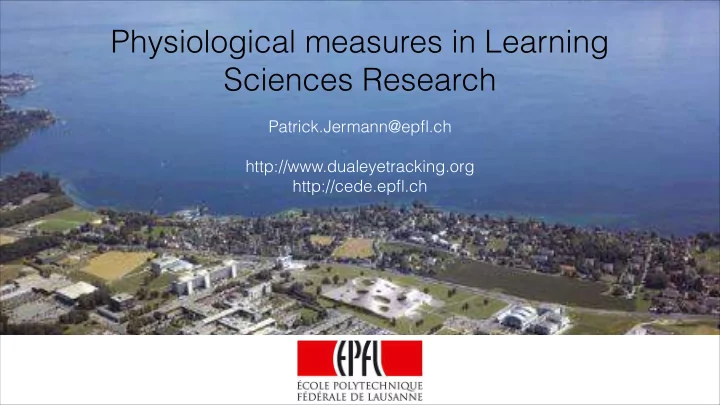

Physiological measures in Learning Sciences Research Patrick.Jermann@epfl.ch http://www.dualeyetracking.org http://cede.epfl.ch
Outline General Framework Referencing Recurrence Moving up the scale
Why physiological measures ? Technology ! Augmented reality Cheap sensors Society ! Self-disclosure of information No more privacy http://www.emotiv.com/ Individualisation ! “Big Data” Services
Activity 1: Do what is written in the bubbles How long does each activity take ? Show where this function Is this function take its zero ? linear ? Read this formula … y=x 2 Where is y on the graph ? Explain why the curve is symmetrical ?
Lord, R. G., & Levy, P. E. (1994). Moving from Cognition to Action: A Control Theory Perspective. Applied Psychology: An International Review, 43(3), 335- 398.
Time scales Cognitive Learning Gaze Time Science Sciences understanding 100 sec recurrence interaction quality [1000 fixations] 10 sec episodes dialogue [100 fixations] eye-voice span grounding 1sec voice-eye span referring [10 fixations] 100 ms fixation perception [250 samples] 4ms raw data [1 sample] Lord, R. G., & Levy, P. E. (1994). Moving from Cognition to Action: A Control Theory Perspective. Applied Psychology: An International Review, 43(3), 335- 398.
Time scales Gaze Learning Sciences Time understanding 100 sec recurrence interaction quality [1000 fixations] 10 sec episodes dialogue [100 fixations] eye-voice span grounding 1sec voice-eye span referring [10 fixations] 100 ms fixation & saccades [250 samples] 4ms raw data [1 sample]
Fixations and Saccades
Activity 2 : Watch MOOC video http://www.youtube.com/watch?v=Ipzw_aFQOkg What is the timing between: 1) The gaze 2) The pointer 3) The voice
Time scales Gaze Learning Sciences Time understanding 100 sec recurrence interaction quality [1000 fixations] 10 sec episodes ? dialogue [100 fixations] eye-voice span grounding 1sec voice-eye span referring [10 fixations] 100 ms fixation [250 samples] 4ms raw data [1 sample]
eye-voice span grounding 1sec voice-eye span referring [10 fixations] Griffin and Bock (2000); Allopenna et al., 2000; Jermann & Nüssli (2012)
Time scales Gaze Learning Sciences Time understanding 100 sec recurrence interaction quality [1000 fixations] 10 sec episodes dialogue [100 fixations] eye-voice span grounding 1sec voice-eye span referring [10 fixations] 100 ms fixation [250 samples] 4ms raw data [1 sample]
Gaze Coupling Daniel Richardson and Rick Dale (2005) http://www.eyethink.org/eye-chat.html http://www.eyethink.org/resources/movies/coordination/friends_example.mp4
Cross-recurrence
Cross-recurrence
Recurrence in pair programming Task: count the number of references • High recurrence http://www.youtube.com/watch? v=dumgo3gPM78 • Low recurrence http://www.youtube.com/watch? v=38qxsyNoAsI
understanding 100 sec recurrence interaction quality [1000 fixations] Richardson & Dale (2005); Richardson, Dale, & Kirkham (2007); Jermann & Nüssli (2012)
Time scales Gaze CSCL Time understanding 100 sec recurrence interaction quality [1000 fixations] 10 sec episodes ? dialogue [100 fixations] eye-voice span grounding 1sec voice-eye span referring [10 fixations] 100 ms fixation [250 samples] 4ms raw data [1 sample]
Attentional map Subject A t=0 0.2 0.2 0.2 0.2 0.2 t=1 0.3 0.3 0.3 t=2 1
Attentional focus entropy = Σ p log(p) Subject A Low focus = high entropy t=0 0.2 0.2 0.2 0.2 0.2 t=1 0.3 0.3 0.3 High focus = low entropy t=2 1
Attentional similarity similarity = Subject A Subject B t=0 0.2 0.2 0.2 0.2 0.2 0.3 0.3 0.3 t=1 0.3 0.3 0.3 similarity = 1 0.3 0.3 0.3 t=2 1 similarity = 0 1
Attentional stability stability = Subject A t=0 0.2 0.2 0.2 0.2 0.2 stability = 0.6 t=1 0.3 0.3 0.3 stability = 0.2 t=2 1 stability = 1 t=3 1
Dialogue coding [Program understanding] Level of abstraction Syntactic level Abstract code World model (OPR) (ACT) (FUN) > 10 lines ! PROG_OPR PROG_ACT PROG_FUN PROG (rare) Scope of 2-10 lines ! METH_OPR METH_ACT METH_FUN reference METH 1 line ! LINE_FUN LINE_OPR LINE_ACT LINE (rare)
Level of abstraction y y y t t i i p l r i a b o l a r i m t t n S i E S OPR ACT FUN OPR ACT FUN OPR ACT FUN Do people speak about concrete operations (OPR) or general functionalities (FUN) ?
Dialogue Coding [Concept Mapping] CMAP Tool functionality COOP Organization EXPLAN-C Giving explanations [C=ref to concept map] EXPLAN-K NEGO-C Negociate knowledge [C=ref to concept map] NEGO-K METACOG Evaluate process M. Sangin. Peer Knowledge Modeling in Computer Supported Collaborative Learning. PhD thesis, Ecole Polytechnique Federale de Lausanne, 2009. ! Sangin, M., Dillenbourg, P., NüssliMarc-Antoine, & MolinariGaëlle. (2008). How learners use awareness cues about their peer's knowledge?: insights from synchronized eye-tracking data. In Proceedings of the 8th international conference on International conference for the learning sciences-Volume 2 (287–294).
F o c u s
Recommend
More recommend